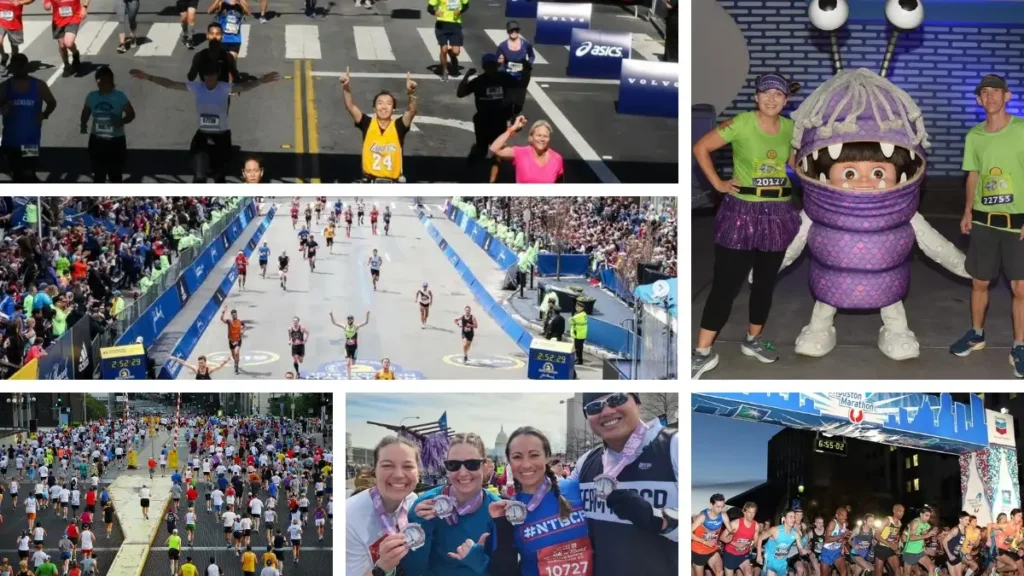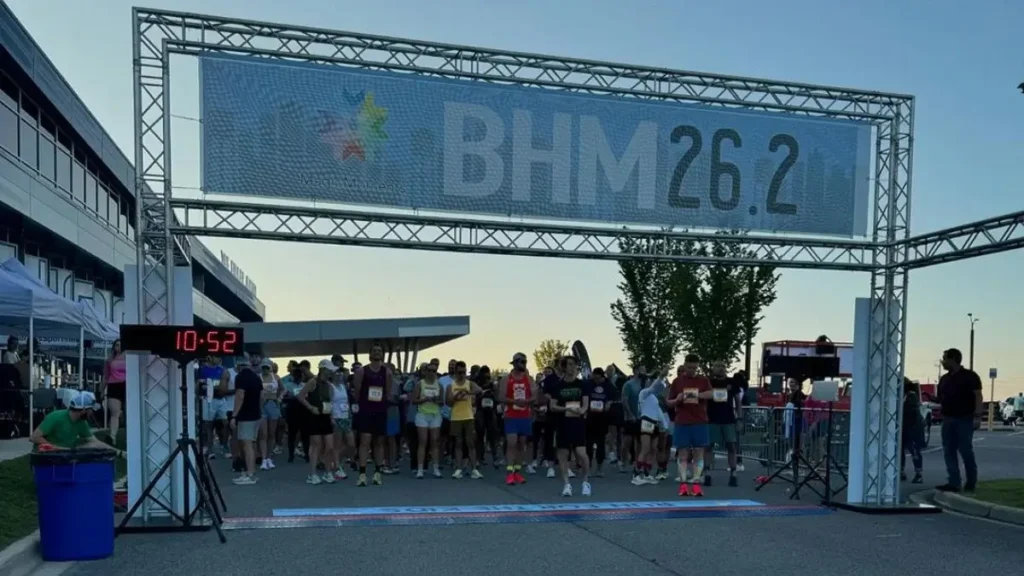From Fargo to Medora to Bismarck, and more.
Running a marathon in North Dakota isn’t about chasing big crowds or postcard backdrops – it’s about space.
Open space. Quiet roads, long horizons.
The state’s running scene is low-key but surprisingly well-loved, anchored by a handful of distinctive marathons that each bring something a little unexpected to the table.
I’ve rounded them up in this post and dropped some tips on weather and training.
Looking for a different state?
What are the Best Marathons in North Dakota?
Fargo Marathon
Fargo, ND | May 30, 2026
Course Type: Very Flat
Elevation Gain: 260 feet (79m)
Participants: 953 Finishers
Price: $90-$120
The Fargo Marathon is what happens when a small city throws its whole heart behind a race – then adds a dozen DJs, a marching band or two, and a finish line inside a football dome. It’s flat, yes (barely 30 feet of elevation gain), but don’t mistake that for boring.
The course weaves through neighborhoods, slips into Moorhead, loops through college campuses, and somehow manages to hit every surface except actual trail. It’s also packed with turns. Like, a lot of turns. By mile 20, you might feel like you’re in a GPS calibration test. But the locals make up for it with some set up sprinklers when the heat kicks in, others hand out snacks or cheer from lawn chairs. Starting and finishing inside the Fargodome is a win, especially when it’s chilly at the start (or blindingly sunny once you’re out on the course).
That said, recent years have felt a bit off. The course got a last-minute reroute due to flooding in 2024, adding more elevation than usual and stretching water stops thin in the second half. And that once-legendary swag? It’s been a mixed bag lately. The race is still a Boston Qualifier and logistically smooth (hello, parking right by the start), but it’s working through a transition phase.
If you’re aiming for a North Dakota marathon and appreciate a fast course with a generous dose of personality, Fargo still earns its place. Just bring a hat, maybe your own water, and get ready to run the tangents, or add a few extra tenths to your day.
Maah Daah Hey Trail Run
Medora, ND | Jul 26, 2025


Course Type: Trail
Elevation Gain: 2,391 feet (729m)
Price: $175
The Maah Daah Hey Trail Run doesn’t ease you in, it drops you straight into a dry creek bed after the first cattle gate, then sends you weaving through a landscape that looks more painted than real.
The marathon course kicks off at Wannagan Campground, and from the start, it’s clear: this is Badlands running. It’s raw, exposed, and weirdly beautiful. The ground underfoot shifts constantly, red scoria one minute, chunky clay the next, then suddenly you’re crunching over sun-baked prairie grass.
Navigation feels part of the challenge: follow wooden posts, neon arrows, the occasional spray-painted turn in the dust. The sun is a constant presence, and there’s barely a tree to hide behind. I’ve read race-day temps can push into the 90s with only two water checkpoints (around mile 11 and 20), so carrying enough hydration isn’t optional; it’s the difference between “finisher” and “found lying in the sagebrush.”
The trail itself isn’t overly technical, but it makes you earn every mile. Long climbs and descents are spaced out like mood swings, and while some parts are runnable, others ask you to slow down, breathe, and accept that it’s going to take a while. There’s something wild about it, in the best way.
The finish line in Medora sneaks up on you after a final push under a bridge and along a paved path, and then just like that, you’re done, dusty, maybe sunburned, but deeply satisfied. This one sticks with you. Not because of fanfare or finisher medals, but because it doesn’t care if you’re having a good time. It’s the Badlands. You came to them.
Bismarck Marathon
Bismarck, ND | Sep 21, 2025


Course Type: Mostly Flat
Elevation Gain: 477 feet (145m)
Participants: 186 Finishers
Price: $115-$125
You can spot the start line of the Bismarck Marathon by the shadow of the State Capitol building. Runners take off from the Capitol grounds and head into a long, winding out-and-back course that sticks close to the Missouri River, occasionally ducking into neighborhoods and popping up along paved trails and narrow sidewalks.
It’s mostly flat, especially early on, but don’t let the elevation chart lull you into complacency; there’s a deceptively tough climb in the last 3 miles. That final stretch? It goes from river-level, up a steep grade through a park, and then runs alongside a highway into downtown. No frills. No shade. Save something for it.
For a race with only around 200 marathoners, the support is surprisingly dialed in. Aid stations feel like they’re everywhere (one nearly every mile), and the volunteers have a way of showing up like they’re exactly where they want to be.
There’s no marathon expo in the traditional sense. Packet pickup is at Scheels, and you literally walk through the store to grab your bib and swag (which recently included a black hoodie and a knit cap—surprisingly solid, and oddly longshoreman-esque). No vendors. No clutter. Just a bib, a shirt, and a quiet confidence that the race knows what it is.
The event itself has been around since 1981, and it shows – in a good way. The logistics are mostly smooth, though race markings have been hit-or-miss in some years, especially on the shared out-and-back sections. That said, the organization feels grounded, like a race that’s been through all kinds of weather (including actual torrential downpours) and still rolls on. It’s a true small-town race with big intentions. Not flashy. Not trying to be anything it’s not. Just a fast, honest marathon through the state capital, backed by people who care enough to make it good.
Training in North Dakota Weather Extremes
There’s no gentle ramp-up when it comes to training through North Dakota’s seasons—you’re either bracing against wind that feels personal or squinting into sun that turns sidewalks into radiators. Summer long runs often start at dawn, not for the sunrise but to avoid hitting 90 degrees before mile six. It’s a dry heat, sure, but that doesn’t mean it’s forgiving. The ground bakes into unforgiving concrete, and any trail with open exposure becomes a slow-roasting treadmill.
Flip the calendar a few months, though, and suddenly you’re weighing the pros and cons of frostbitten cheeks. January doesn’t care about your tempo pace – it’s more concerned with whether your eyelids will unstick mid-run. And when the sidewalks disappear under packed snow, you start to get creative: loops in the mall parking lot, indoor tracks at the Y, or just surrendering to the hum of the treadmill at Scheels.
Still, the swings in weather breed a certain kind of runner. People who don’t flinch when race day throws a surprise downpour, like at the 2022 Bismarck Marathon. Runners who show up early to their Saturday group run in knit caps and leave in tank tops. Training here means adapting constantly. If the wind changes mid-run, so does your route. If it’s 40°F in April, you call it spring. That kind of unpredictability doesn’t just shape your fitness – it shapes your mindset. You’re not just logging miles. You’re learning to show up anyway.
Small-Town Hospitality and Quirky Race Traditions
North Dakota races tend to operate on their own wavelength—low-key, deeply organized, and full of little surprises. It’s the kind of place where you might pick up your race packet by walking through a giant sporting goods store (hello, Scheels), grab your bib from a folding table wedged between camping gear and football cleats, and somehow still feel like it all makes perfect sense. There’s no flashy expo. No walls of sponsor booths. Just a solid hoodie, a knit cap, maybe a local discount or two, and a volunteer who seems genuinely happy you’re there.
During the race, that same vibe holds steady. The Bismarck Marathon, for example, leans into its Capitol City backdrop without trying to be too showy. There’s a kind of quiet pride in how the course threads through local parks and historic neighborhoods. And while the races aren’t packed with thousands of people, the ones who do show up – especially the volunteers—bring a kind of small-town magic that’s hard to fake. Aid stations are frequent, yes, but also surprisingly fun: upbeat, generous, and sometimes manned by folks who’ve been doing this for years.
And then there are the stories you only hear if you’ve stuck around. Like the time the women’s winner of Bismarck was suspected of cutting the course, but the community quietly debated it like a hometown mystery, rather than a scandal. Or how some runners cap off their marathon with a beer, then keep the celebration going on a pub crawl with complete strangers who suddenly feel like old friends. That’s the kind of tradition you won’t find printed in the race guide. But in North Dakota, it’s very much part of the run.
Conclusion
There’s a certain stillness to running in North Dakota – not in a boring way, but in a way that lets you hear your own breath, notice your stride, and tune in to the work you’re doing. These races don’t need loud music or flashing lights to make you feel like you’ve done something big. The challenge is quieter here. Fewer distractions. Fewer runners. Fewer reasons to run except the ones that actually matter.
Whether you’re hoping for a PR on a fast road course or just trying to hold your own against a trail that doesn’t care about your splits, North Dakota delivers in its own way. The state’s marathons are stitched into the fabric of its towns, shaped by weather and terrain that doesn’t apologize, and held together by the kind of hospitality that feels real. It’s not the easiest place to run—but maybe that’s the point.

Row Brown is the founder of Refresh Row. He is a keen marathon runner, his favorite being the London Marathon. He’s now set himself the mission of Running the Entire Length of Spain, which is scheduled for late 2024.



